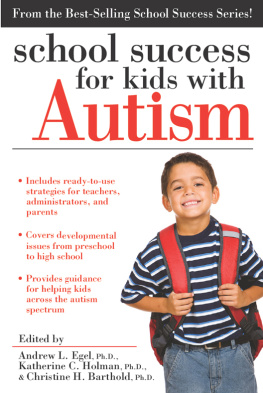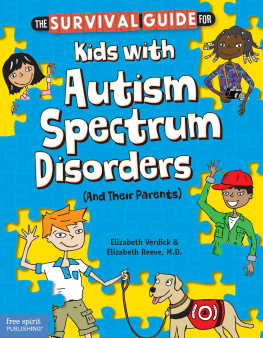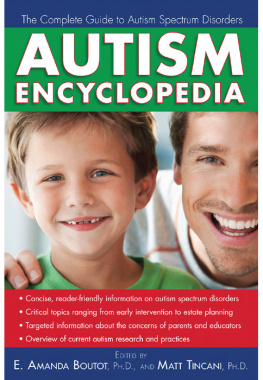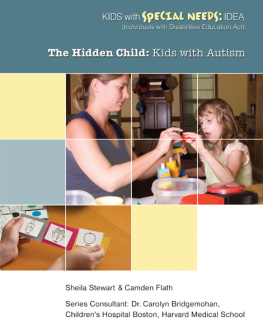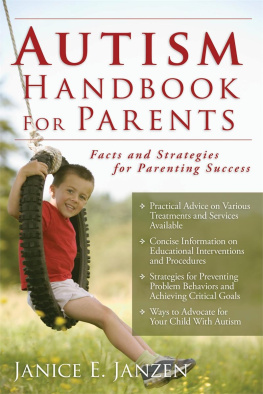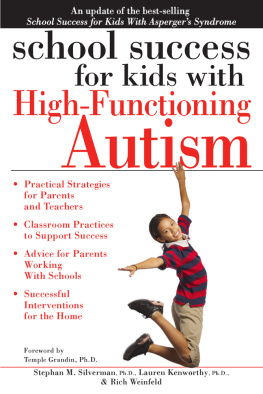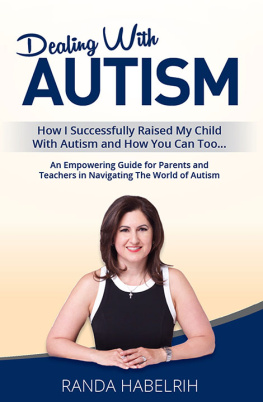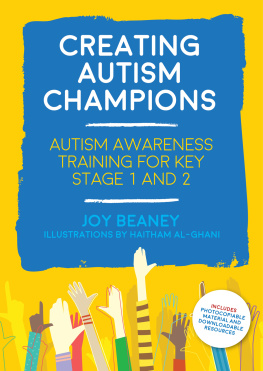I would like to thank my wife, Gina, for her support throughout this process; Lacy Compton for her careful reading and thoughtful comments; and Juli Katon for helping us ensure that the references for each chapter were complete. I especially want to thank the children with ASD and their families and teachers who have taught me so much about what is required to develop successful programs in schools, homes, and communities.A. L. E.
I would first like to acknowledge my family for their unending support throughout this process, particularly my husband, Dusky, for his thoughtful edits and belief in me and this project. Thank you to Betsy Neville for her time and sincere encouragement. And last, but certainly not least, I am sincerely grateful to the children with ASD and their families, who have trusted in me and provided the amazing opportunity to work and learn from them in such a meaningful way.K. C. H.
To my husband Ralph, who read drafts and provided feedback and, most importantly, support throughout the process. I would also like to acknowledge the children and adults with ASD who I serve and who challenge my assumptions every day.C. H. B.
Introduction
Sara G. Egorin-Hooper
A true friend knows your weaknesses but shows you your strengths; feels your fears but fortifies your faith; sees your anxieties but frees your spirit; recognizes your disabilities but emphasizes your possibilities.
William Arthur Ward
IMAGINE your favorite friends coming over to spend the day to share adventure, food, and fun. You begin to think about your friends interests, foods they love, and meaningful ways you can connect with them. You want to be respectful of and sensitive to each friends unique interests and needs. You know that one friend has several food allergies that will require some planning and creative cooking. Some of your friends are active and love to hike while others tire more easily and enjoy hanging out. These individual differences comprise the mixed group of friends who will soon be a special part of your planned day. You want to accommodate individually as well as collectively.
In preparing for their arrival, you think about what your friends will enjoy doing and set up the day based on what you know about them. You make a variety of dishes so there are some yummy choices for all. You would never think of saying, Well, this is all I made to eat, so its too bad that you cant eat whats here; youll just have to watch the rest of us while we eat. After lunch, you choose a walking path, one with benches, so anyone can stop and pause during the walk if needed. You would never say to your friend, Im sorry youre so wiped outhang in there, we only have 5 more miles to go. Clearly, what sensitive, caring people intentionally do is consider the interests, capabilities, and needs of those with whom they will be sharing time and space.
These are some of the considerations for creating a successful classroom experience for students with an autism spectrum disorder (ASD). Todays classrooms are made up of a very diverse group of students and each student has his own learning style. The student with an ASD brings his own unique learning strengths and challenges to a classroom, and there are both universal (meaning strategies that are helpful to all students) and ASD-specific strategies that can be put in place to ensure a positive and successful learning environment. This book will guide both educators and parents through these strategies across the age-span; however, despite the age of the student or the type of classroom, the fundamental component for success is the ability for teachers to create connections with and between their students.
Teachers are responsible for orchestrating meaningful relationships and learning in their classrooms each day. To accomplish this goal, teachers must demonstrate the willingness and open-mindedness to see the value of establishing an environment where their caring actions make a positive impact for students and embrace the opportunity to create an energizing classroom where all students belong and are invited to feel that their unique gifts are recognized and celebrated.
Creating an Inviting Classroom Community
Every day in a classroom needs to be like preparing for a visit from favorite friends. Just as you sustain your friends and are in turn sustained by them, the same dynamic exists between a teacher and her students. Teachers must also make the effort to create a memorable and mutually worthwhile classroom experience for all. Students and their families need to feel a sense of belonging from the moment they walk into the school.
Universal Educators
Every human being who touches the students life is to be viewed as a universal educator, including families who are integral and must be valued for their connection to and understanding of the whole student. Universal educators live and foster the message that we are all students and teachers to each other, and learning is about taking in and making sense of experiences wherever we are and with whomever we are in life.
The best universal educators dont see disability as a deficit, but rather as a difference. They use these differences as tools to motivate, teach, support, and actively engage each student in learning.
The best universal educators model sincere, genuine appreciation and acknowledgment of each individual with whom they work, and then act intentionally to put purposeful strategies and supports in place.
The best universal educators provide opportunities for students to contribute to the whole classrather than always being the ones who are helped.
The best universal educators respect, acknowledge, and consider ways to make learning accessible to students through choices that empower students, contribute to their success, and encourage them to take risks.
The best universal educators, regardless of their title or role, continually reflect upon these qualities and imagine the possibilities that can and do result for students when meaningful, relevant classroom and instructional considerations are in place.
Thinking into the past to reflect on a favorite teacher conjures up first and foremost a memorable person who made us feel welcomed and valued in so many ways and modeled the real three Rs: relationships, respect, and relevance (not your grandmothers readin, writin, and rithmetic). Imagine a teacher who did this for you.

